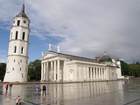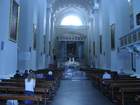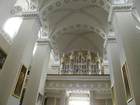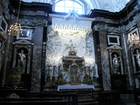About company
Updated on: 2010-10-25 21:57 Views from 2009-08-25: 0
Vilnius Cathedral
|
Short description:St. Stanislaw and St. Wladislaw Cathedral Basilica Keywords:cathedral |
Main catalog categories:
Other categories: [+] |
Cathedral Square is the place where the history of Vilnius begins. Long before Lithuania converted to Christianity (this happened in 1387), this place had been the main pagan sanctuary in the country. Before the Christian period, a pagan shrine is believed to have stood on the place of the Vilnius Cathedral (its full name is St. Stanislaw and St. Wladislaw Cathedral Basilica). The first church was built here by King Mindaugas in the 13th century, and since that time it was rebuilt numerous times, till it took the shape of the modern Classicist style building. The three sculptures that you can see on the pediment are the sculpures of St. Stanislav, St. Helen and St. Casimir (the patron saint of Lithuania). Turn around to see Gediminas Avenue, the central and most crowded street in Vilnius. Take a walk around the Cathedral. Look out for the reddish tiles on the square, marking the old castle wall, destroyed long time ago. As you pass the sculptures on the left side of the Cathedral (these are the rulers of Lithuania and Poland), make a stop by a beautiful grey chapel at the right rear corner on the Cathedral. You will hardly miss it – unlike the rest of the Cathedral, this chapel is Baroque. This is St. Casimir Chapel, the place where the remains of Lithuania’s Patron are preserved. Note the memorial plaque on the wall of the Chapel. If you have some free time, enter the Cathedral (there is a second entrance on its right side) to admire the interior of St. Casimir Chapel. Be sure – being one of the most remarkable examples of Baroque style in Europe, this place is worth visiting. In addition to the beautifully decorated altar (by Pietro Perti), two large frescoes (by Michelangelo Palloni), silver sculptures of Lithuanian and Polish rulers, the most important object in this chapel is a large coffin with the remains of St. Casimir. Thousands and thousands of pilgrims visit this sacred place annually, not to mention tourists.
We exit the Cathedral from the same side as we entered. On your right, stands a big monument depicting a man holding a sword, with his horse. This is Grand Duke Gediminas, the founder of the city. According to the legend, he founded Vilnius at this place under the influence of his dream in which he saw an iron wolf howling on top of what is now known as the Gediminas hill (it is on your left). Look out for a wolf embedded in the monument – an iron wolf is the symbol of this city. On your left, just behind the Cathedral, there is a big castle. There are building works going on here. The building, towering at this site is the newly rebuilt Lower Palace, a copy of the Palace of Great Dukes, dating to the 13th century and destroyed in the 18th century. Today Lithuanians are rebuilding it to remind the world of the glory and uniqueness of what was once ruined.





